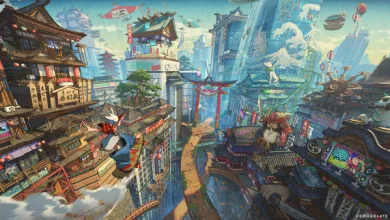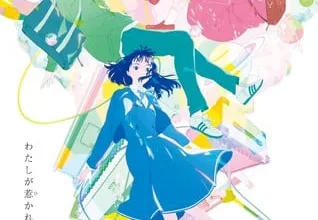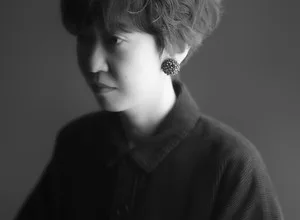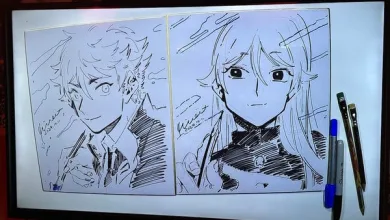Guilty Gear’s Artistic Identity and Upcoming Anime with Ken Miyauchi, Shoichi Kitazono, and Genki Mamada
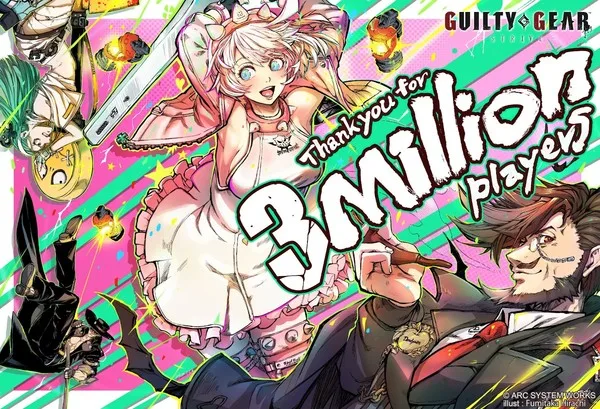
GUILTY GEAR -STRIVE-, which recently surpassed 3 million players and has an anime adaptation in the works, is arguably the most stylish fighting game currently on the market. Moreover, it leans very heavily into this stylishness by allowing its visuals to play a role in certain gameplay mechanics as well as the game’s identity as a whole. At EVO, ANN got to chat with Ken Miyauchi, Shoichi Kitazono, and Genki Mamada from Arc System Works about Guilty Gear‘s visual identity and the highly anticipated upcoming anime. Miyauchi speaks English and was thus able to respond for himself throughout the interview. The rest of the conversation was carried out thanks to the indispensable help of translator Yuji Moriya.
Could you introduce yourselves, please?
Ken MIYAUCHI: My name is Ken Miyauchi. I’m a Guilty Gear producer. Before becoming a Guilty Gear producer, I worked with Takeshi Yamanaka, the previous producer, as an assistant producer. I was in charge of Arc System Works America, doing business development at the U.S. branch office. Now, I’m a Guilty Gear producer since GUILTY GEAR -STRIVE- Season 2.
Genki MAMADA: My name is Mamada, an environmental designer at Arc System Works. I have been working on environment art and design since GUILTY GEAR Xrd, at the start of GUILTY GEAR Xrd, and up to Strive. Currently, I’m not the lead designer for Strive, but I have been in the lead position for the previous installments. And I’ve also worked on various other titles as an environmental artist.
Shoichi KITAZONO: My name is Shoichi Kitazono, a 2D designer and artist at Arc System Works, and I mainly work on the concept art and the key art for the characters.
I’d like to first ask about the environments of Guilty Gear. We’ve had other fighting games where certain stages will take you into other areas, but none have done it as stylish as GUILTY GEAR -STRIVE- has, where you have that screen-breaking moment, and it’s a whole mechanic. I wanted to hear about what inspired that decision.
MAMADA: So the whole mechanic of the wall break, this was something that we experimented extensively on. We had a lot of discussions about it. We debated over what to do, how to make this happen, or what direction to take. We conducted many, many tests to come up with this unique system. And we struggled to nail down what we wanted to do or where to take it. Still, once we reached the consensus, we wanted to focus on a seamless design, a transition between stages.
So you might see other games where there are screen transitions or stage transitions during the battle. But many of those stage transitions have, maybe, loading screens in the middle—there’s a little blank screen in the middle. So there’s a cut-off between the first stage and the second stage. But we wanted Strive to be seamless—that there’s no cut-off or anything like that. I think that brings out this connectedness to each of the stages. It makes you feel like you’re playing in a world that is connected in each area or connected to each other, and they’re related.
And what you mentioned as well, is that it’s incorporated into the whole mechanic of the dust attack. This design integrated the background and stage transitions with the fighting mechanic. Being able to handle both of those things and integrating them is one of our greatest achievements for this game.
That’s really cool! Artistically, what is your favorite part about these changing environments?
KITAZONO: I like this stage where the giant statue of the Buddha launches in the air. It’s something that calls back my childhood memories. When I was a child, I was intrigued by these massive structures and statues. So when I see something like that on the stage get launched into the air, it’s like, wow. It brings back childhood memories of being wild and intrigued by giant structures and statues. And there’s another stage where there’s a shrine, and I always thought that the fox hanging around in the shrine was very cute.
MAMADA: I’ve been incorporating a lot of drama into the stages. One of the examples is that in this forest stage, there’s a treehouse in the background. And in that tree house is a bunch of NPCs. And you can see them doing stuff. If you look closely, it’s a factory, and they’re producing this mysterious purple potion, and there’s a witch concocting it. It’s a whole factory setup.
You can actually see the different production stages if you transition into different areas of the stages. So you can see the potion being made here, transferred to other places, and produced. That’s something we can achieve because we have so many different areas to work with, and we can tell this interesting story from the background and what’s going on, making these changes between these areas visible to the player. That’s something unique that we can do because we have this multi-stage setup.
MIYAUCHI: One thing that I like about the GUILTY GEAR -STRIVE- environment is the lighting—how the character is not just put as an object and then on a stage. On the stage, there’s a different variety of lighting. If it’s a forest stage, there’s sunlight going through the tree leaves. Or, for example, if you go to some snow stage, the lighting changes—the character color is a little saturated. You can see that the character is in that environment, which makes Guilty Gear characters feel like they are living in that world, not just like this is the stage, that’s a battle stage, and the character is fighting on that stage. It’s more like they live in Guilty Gear. So that’s what I like about it.
Now, the use of Guilty Gear environments as a whole mechanic, I think, is a great example of how Guilty Gear marries its art and its gameplay, I think more than any other fighting game currently on the market. I was wondering if all of you would agree with that, and also, if you do, why do you think the art is so important to Guilty Gear? What do you think makes the heart of Guilty Gear?
MIYAUCHI: Honestly, I think we put the most effort into the visual-looking element in any other Arc Sys Works title. And we are proud to be at the top on the visual level. And of course, there’s a balance of it, since it’s a fighting game, there needs to be a balance of visibility. If it’s too much of the visual effect or the environmental effect, it could be making the game a little hard to play, but we always—that doesn’t mean we give up on stylish visuals, but we put the best effort to balance that. And I think that’s one of the directions—I will need to confirm with these two, but that’s one of the directions that our art director is always trying to put so much effort into.
MAMADA: So, this is a personal opinion, but when we talk about Guilty Gear, we often use the keyword “anime.” So we might say, “Guilty Gear is very anime,” or maybe, “Some parts of it are not very anime,” but in either case, anime is a keyword that comes up when we talk about Guilty Gear.
This cell-shaded look is a reflection of the anime style that originated in Japan. The whole culture of anime is from Japan. And this thing that we’ve developed over years and generations—this culture of anime—we wanted to put into a game and have it delivered in this new and special way.
I think we at Arc System Works, take this as a specialty—this idea of taking this anime aesthetic and putting it into a game. That becomes our identity. This is not just limited to the character design but also the environment, background, and everything else. We have this whole field of environmental art, and it’s a whole technology of optimizing the visual—artistically, from the background and the character, and optimizing how much of the character you can see, given a specific background. This practice of environmental art has been practiced for many generations, and it’s a huge part of the tradition that we have in Japan and a huge part of Japanese culture.
I believe GUILTY GEAR -STRIVE- is one of the best mediums out there right now that encapsulates Japanese culture and art culture in a video game format.
KITAZONO: I don’t know why the art is important. I don’t have a specific answer to that. All I know is that this is the reality that we’re working in, and there’s no other way. And when I see other titles or other games doing the art or the visuals better than Guilty Gear, I always want to surpass that—or I get mad when I see other games do something better when it comes to visuals and art. My goal is to try to maintain being the best at doing the 2D art, the visuals and making Guilty Gear look the best that it can be.
On the topic of anime, are you excited about the upcoming Guilty Gear anime?
MIYAUCHI: That’s a question that I also would like to ask, too [laughs]. Well, I’m looking very forward to it because it’s one of the projects I’ve been working on since I joined Arc System Works. We announced it at Anime Expo in July. And I see a lot of Guilty Gear fans being excited about the first-time series anime adaptation. From the quality perspective, I have quite a lot of trust in the very, very well-done, cel-looking 3D anime production company called SANZIGEN. They’re working on a very, very good performance. So, I’m excited to see the finished work and how people react to each episode.
KITAZONO: I’m looking forward to it, too.
MAMADA: I’m very, very excited. I’m not too familiar with what’s going to be in it or what it’s about exactly. But I know that there are many anime fans out there who are not necessarily gamers themselves. And so I’m excited for our game, Guilty Gear, to reach new audiences worldwide. So I’m very, very excited about that.
MIYAUCHI: Most of us are thinking that we’re looking forward to the anime because we are video game developers and can’t make anime. But now, the anime project is being worked on by professionals who’ve been working on anime series for a long time. It’s a different media. We all look forward to how Guilty Gear‘s world will be visualized in the anime media.
So, Miyauchi-san, you mentioned a moment ago that you’ve been working on this anime since you got with Arc System Works. Can I ask how long it’s been in the works?
MIYAUCHI: I joined Arc System Works at the beginning of 2018. And what I’ve been—initially, of course, I didn’t go straight into this project, but then the anime project started planning around the year 2019. So, ever since I’ve been working closely with Takeshi Yamanaka, he also helped put the project together and get the anime work budget approved by the company. That procedure took a long time, and the actual production started about a year ago. So that’s why I said it’s since I joined the company.
Source link
#Guilty #Gears #Artistic #Identity #Upcoming #Anime #Ken #Miyauchi #Shoichi #Kitazono #Genki #Mamada

